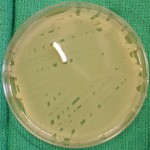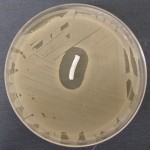Plastic Surgery is unique amongst the medical specialities in that many of our procedures involve using synthetic implants. Only Orthopedic Surgery rivals or exceeds the number of implants placed per procedures. As a result, plastic surgeons have a long history of implant handling and implantation, particularly for elective cosmetic surgery. Breast and facial implants come most commonly to mind.
As part of implanting synthetic materials comes the risk of postoperative infection. The majority of surgical implant infections occur early after surgery, within weeks or a month, and are the result of being inoculated at the time of implantation. Most commonly, the source of inoculation is bacteria from the patient themselves coming from the skin or other surfaces that are heavily colonized. Whether adhering onto the implant by passing through the skin or having cross-contamination from instruments or gloved hands, bacteria that lodge into the implant’s surface may turn into an infection later.
Antibiotics are widely used in plastic surgery and certainly are routinuely done when it involves a procedure in which a synthetic implant is used. Antibiotics are given intravenously during surgery and by the oral route afterwards. The purpose of antibiotics circulating through your blood stream is that they will reach the implant site by blood vessels that surround it. Once there, the antibiotic molecule will not only prevent any bacteria on the implant from replicating but will then destroy those that are present.
Another common plastic surgery practice, in addition to systemic antibiotics, is to soak or wash the implant in an antibiotic solution prior to implanting it. This intraoperative method is an insurance policy that has two purposes. First, it will hopefully wash any off any bacteria that may have inadvertently become stuck on the implant’s surface. Secondly, some of the antibiotic may remain attached to the implant so it may work its magic against any neighboring or remaining attached bacteria.
I have always wondered how effective, or if it is effective at all, that implant washing in antibiotics before implantation may be. Would washing the implant in saline alone be just as effective? After all, many implants have quite hydrophobic (water repelling) surfaces that do not have the capability to absorb any fluids even if they are antibiotics.
Therefore, I designed a simple bacterial culture experiment. Using 1 cm long pieces of surgical Gore-Tex tubes (fairly hydrophobic surfaces), they were both swabbed with staphalococcus aureus cultures and then soaked for one minute in an antibiotic solution or in a saline solution. They were then placed petri dishes that had also been wiped with the same bacteria and then grown in culture for a week. What did I observe?


The conclusion is that, not surprisingly, the soaking or washing of an implant is helpful for bacterial growth inhibition. Even in the face of an implant surface that does not appear to be particularly absorptive, a significant beneficial effect was seen.The combination of systemic and local antibiotic application when placing synthetic implants is a prudent approach that merits its continued use.
Dr. Barry Eppley
Indianapolis, Indiana


